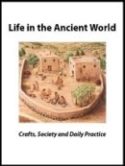BAR Test Kitchen
Eat like the ancients
This BAR feature hopes to introduce you to a new—yet old—kind of cooking. If you have ever wanted to eat like an ancient person, whether Babylonian, Roman, or Syrian, now you can. We’ve tracked down ancient recipes and tried to recreate them using modern ingredients, so that you, too, can enjoy these dishes. Join us on a gastronomical adventure!
Parsnips
Parsnips are an underappreciated vegetable in the U.S. Depending on where you are, they can be difficult to track down, and many Americans have only a vague notion of what a parsnip actually is. In my opinion, though, they are delicious and well worth the hunt.
Click here to get the recipe for Parsnips >>
Tah’u Stew
Eat like an ancient Babylonian with this savory recipe for tah’u stew, which calls for lamb shank, beer, beets, onions, and a number of other vegetables. Discovered on Yale Babylonian Collection Tablet number 4644, the recipe is written in Akkadian and dates to c. 1750 B.C.E. Perhaps you may better appreciate ancient Mesopotamian culture over a bowl of Tah’u Stew.
Click here to get the recipe for Tah’u Stew >>
Roman Custard
Next on the menu is a sweet custard from ancient Rome. The recipe comes from the only Roman cookbook that has survived from antiquity, De Re Coquinaria (On the Subject of Cooking), written by Apicius—a pseudonym, as Apicius was a nickname for “gourmet.” Made of eggs, honey, and milk, this delicious custard is sure to delight the diner.
Click here to get the recipe for Roman Custard >>
Mersu
 For this pastry dish, we journeyed back to the Bronze Age site of Mari, Syria (c. 1775–1761 B.C.E.). Mersu was an ancient type of “cake” that involved mixing flour with a liquid (water, milk, oil, beer, or even butter). Various inclusions (dates, pistachios, figs, raisins, and spices, such as cumin and coriander) were sometimes added. BAR’s variation is sweetened with dates and pistachios. Enjoy!
For this pastry dish, we journeyed back to the Bronze Age site of Mari, Syria (c. 1775–1761 B.C.E.). Mersu was an ancient type of “cake” that involved mixing flour with a liquid (water, milk, oil, beer, or even butter). Various inclusions (dates, pistachios, figs, raisins, and spices, such as cumin and coriander) were sometimes added. BAR’s variation is sweetened with dates and pistachios. Enjoy!
Click here to get the recipe for Mersu >>

FREE eBook: Life in the Ancient World.
Craft centers in Jerusalem, family structure across Israel and ancient practices—from dining to makeup—through the Mediterranean world.
More on ancient food in Bible History Daily:
14,400-Year-Old Flatbreads Unearthed in Jordan
Biblical Bread: Baking Like the Ancient Israelites by Cynthia Shafer-Elliott
Fruit in the Bible by David Moster
The 10 Strangest Foods in the Bible by David Moster
Must-Read Free eBooks
Want more Bible history?
Sign up to receive our email newsletter and never miss an update.
Unlock Unlimited Access to the Bible's Past
Become an All-Access Member to explore the Bible's rich history. Get Biblical Archaeology Review in print, full online access, and FREE online talks. Plus, enjoy special Travel/Study discounts. Don't miss out—begin your journey today!














Love this! I’d like to see more!